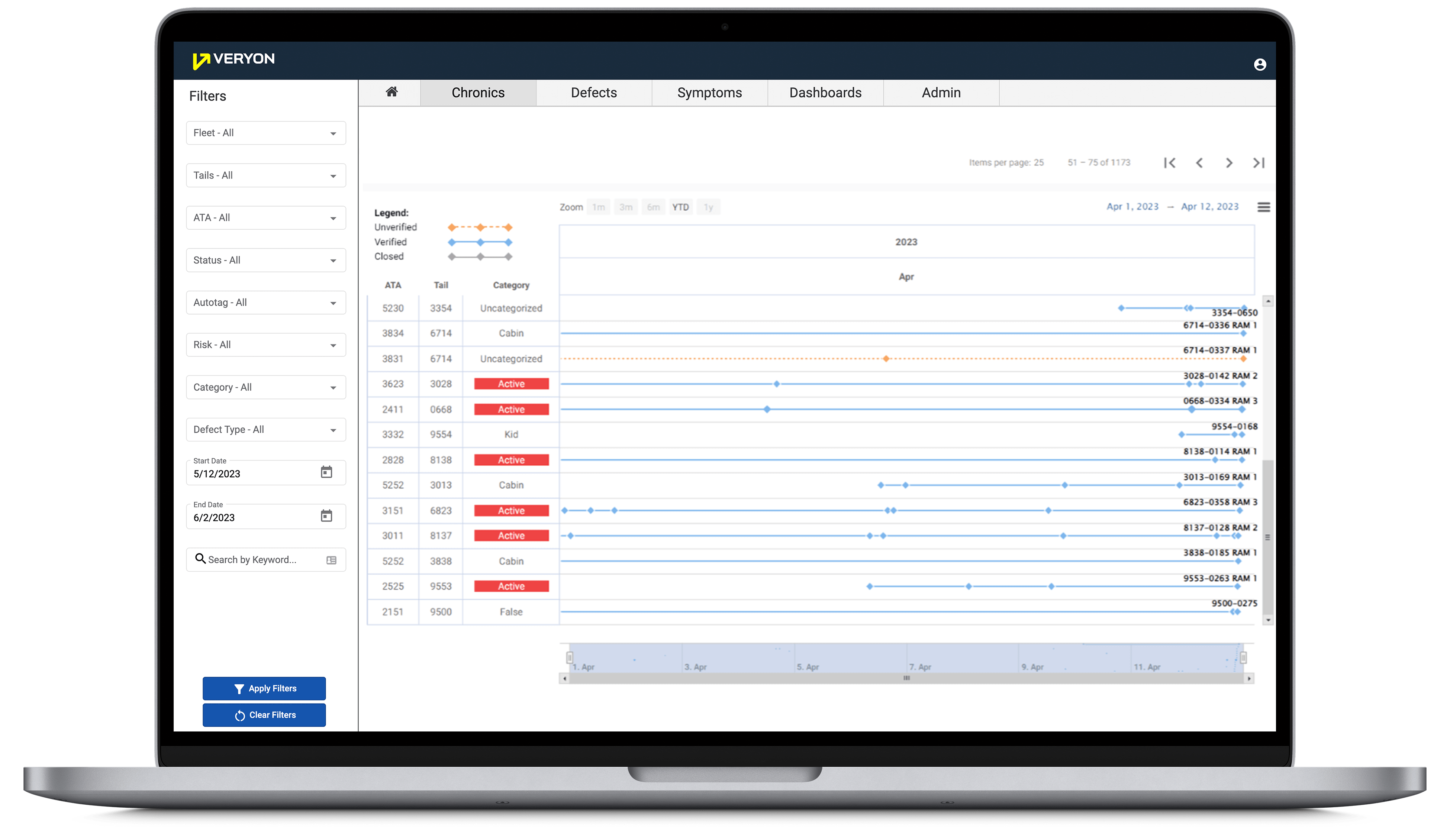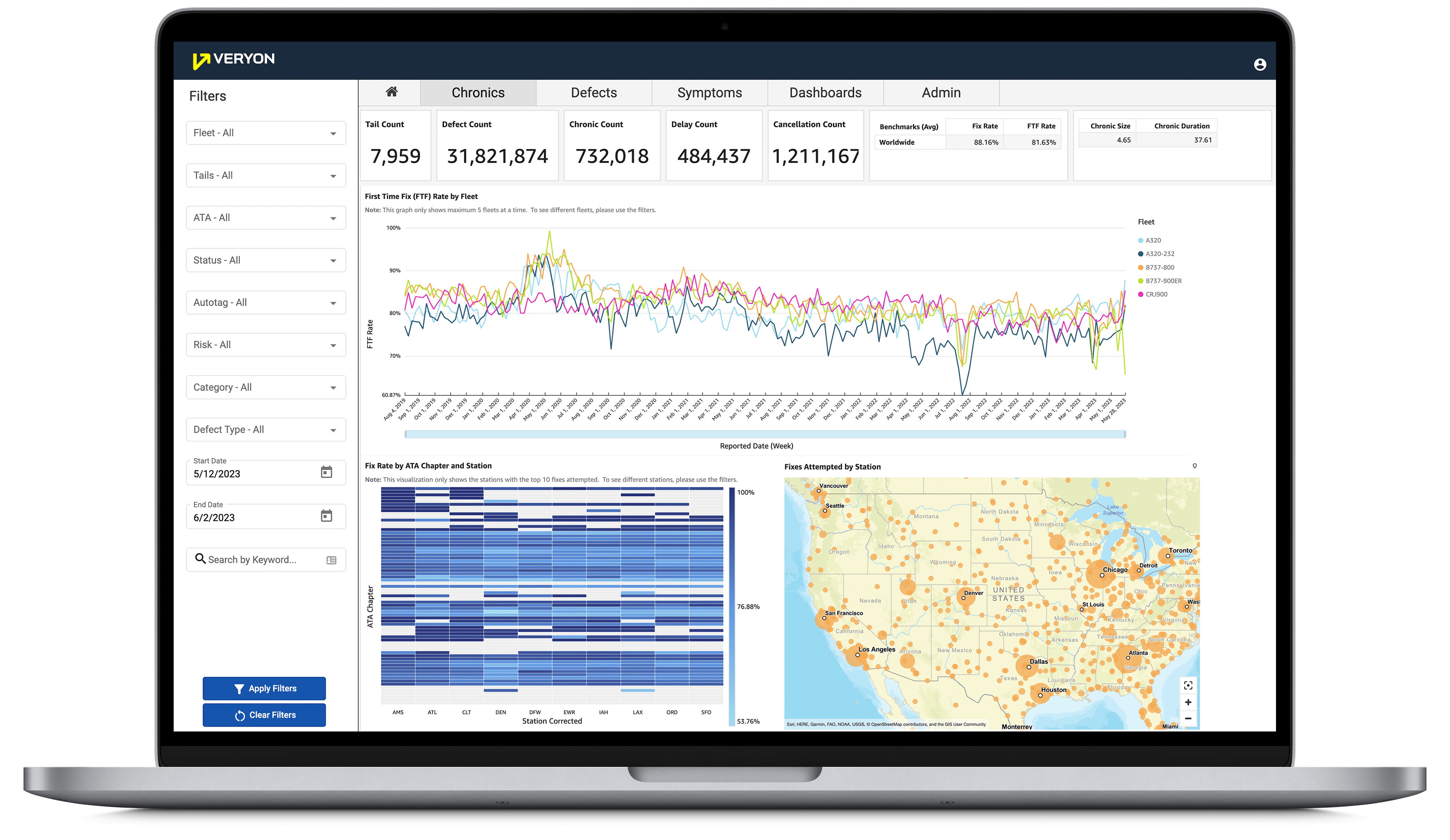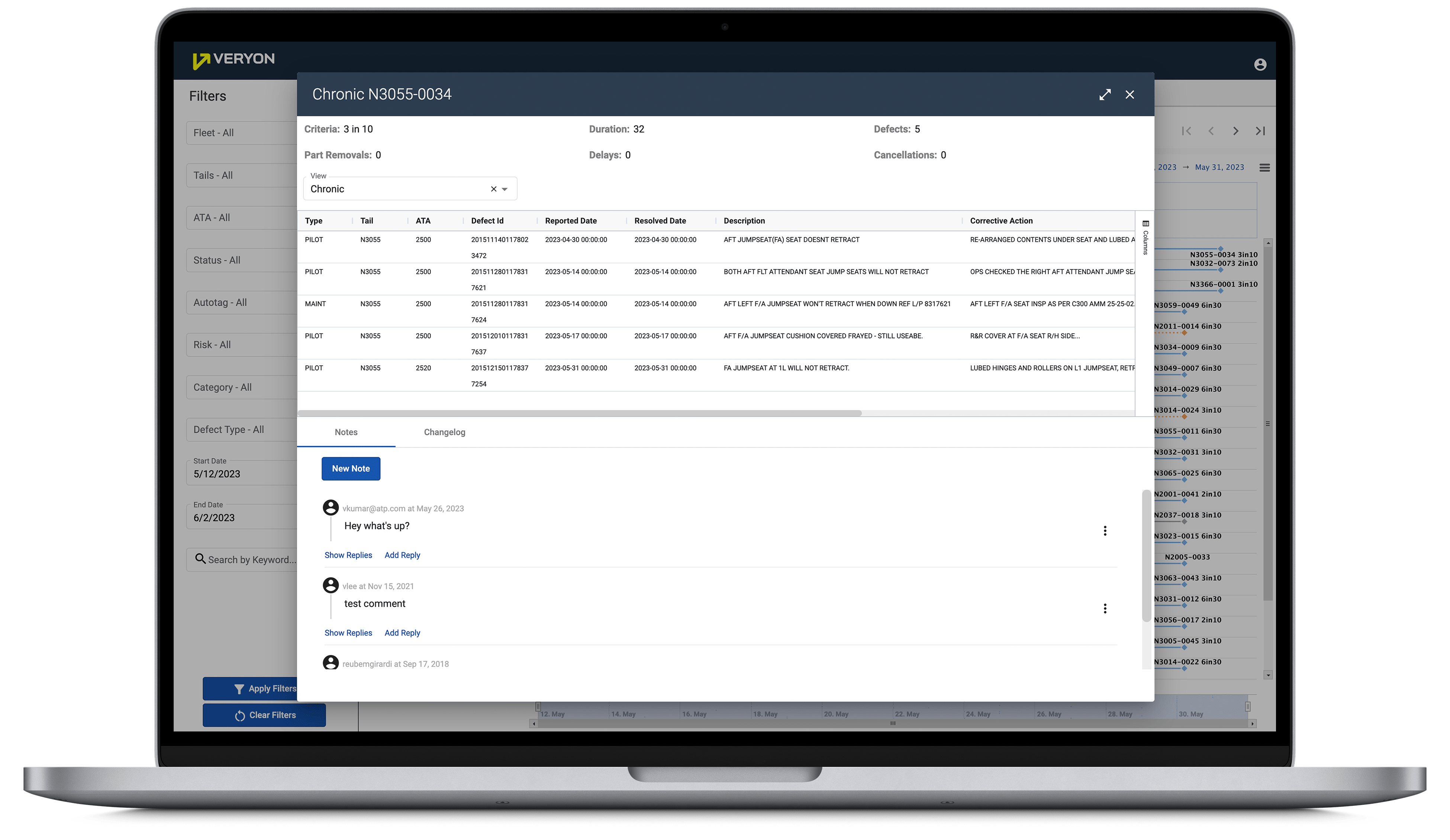10 min read
How Veryon Transformed Maintenance Efficiency for This Commercial Airline’s Fleet
Veryon : Apr 7, 2025 11:51:48 AM
At the recent 2024 Airline and Aerospace MRO and Flight Operations IT Conference in Miami, Florida, Veryon showcased its many strategies and industry-disrupting products poised to greatly reduce the impact of unscheduled maintenance for aviation companies around the globe. Attendees saw demos of the latest digital solutions and discussed challenges and priorities in the industry.
Veryon highlighted its answer for commercial operators to reduce delays and cancellations, delivered in a single seamless aviation management software solution: Veryon Diagnostics.
Championed by 25 percent of the worldwide commercial fleet, Veryon Diagnostics sets the industry standard in improving aircraft availability by reducing troubleshooting time by nearly 50 percent and lifting first-time fix rates.
Veryon also demonstrated how airlines, operators, and MROs can minimize the impact of unscheduled maintenance through Veryon Tracking+. As an end-to-end aircraft management platform for commercial airlines, MROs, rotary, and military operations, Veryon Tracking+ delivers comprehensive cloud-based software for fleet management, maintenance, inventory, and flight operations.
During the conference, Veryon hosted a panel moderated by Robert Ross, Veryon Enterprise Account Executive, with maintenance management executives from Delta Air Lines, one of the largest commercial airlines in the world. They discussed how Veryon technology and its defect analysis tools have transformed the Delta worldwide aircraft fleet's maintenance efficiency.

Below is a recap of that discussion:
Robert: Veryon's aviation management solutions are designed for business and commercial aviation. Our core offerings include custom notifications and alerts designed to keep you informed in real time. We also provide fleet-level clustering, allowing you to drill down into specific fleets and tails. Our first-time fixed classification system identifies the most effective corrective action so you can apply those directly in the field. This eliminates the need to go through all the tedious troubleshooting tasks normally common in non-routines. The platform also offers a synonym dictionary, which is a linguistics database we've compiled over the last decade from various aircraft types, as well as providing dashboards and reports, so you have those additional KPIs and benchmarks to work from.
Valued, long-term customers Chris Womack and Chip Cotton join us to talk about their experience using Veryon products and how it has affected their overall maintenance operations at Delta.
Robert: Can you give us a little background on Delta's current operation and your role with the company?
Chris: I've been with Delta for 33 years in January. I work in the maintenance control center. I currently manage the Veryon Diagnostics program and our ODI program.
Chip: I've been with Delta for 35 years, 20 of which have been within maintenance control. I'm currently the manager of the fleet specialists. We have a team of mechanics throughout the country. We go and fix chronic aircraft problems, as well as repetitive hard-to-fix items. It's great to have some of the best troubleshooters in the industry at our airline.
Robert: What kind of challenges did Delta have before using Defect Analysis? What kind of problems were you trying to solve?
Chip: So, I actually was tasked with reducing repetitive chronic faults. We had an internal program that was ATA-based. With that, it had huge limitations. You would not see if you had an APU error problem, and it could be in chapter 36 or it could be in chapter 49. The old system would miss it. The natural language processor and the text mining that Veryon Diagnostics gave us actually pushed those two together. I was tasked with reducing the number of chronics we had, but when we brought on Veryon, our chronics increased because of new awareness. Those chronics were always out there, we just didn't see them. That was one of the biggest things that came to us.
Robert: What kind of impact did that have on the business, what other solutions did you try to pass, and why were they unsuccessful?
Chip: The ATA-based system was homegrown. It worked pretty well, but it also only ran once a day, which was a limitation. Now, we get these hourly updates when chronics come in, so we can react to them quicker. It is a big benefit to us.
Also, what we found out is that when we identified more chronics, we actually knocked them out quicker. The biggest problem you'll have with repetitive items is finding them. Once you find them, you can fix them. Usually, you can see what happened. It's pretty simple stuff. It's not hard. But if you're not aware of it, you're going to run three, four, five items off. You're going to be doing log pages and crew write-ups every time, and the system's not working. Operationally, it makes a lot of sense. Knock these out as fast as you can.
Robert: Delta has been using this product since 2019. It's evolved tremendously since then, but could you give a little background about how you came across the product and what led you to us essentially?
Chip: We looked at a number of products. We had it narrowed down to two. Veryon Diagnostics was one of them at the time. The search capabilities and the speed of giving the information back is really what tipped it for me when I saw the two. We ran a side-by-side comparison for six months using our old system and a new system, and I saw that Veryon Diagnostics ended up catching everything the old system did and more. Then it was just a matter of making the deal and getting it done.
Robert: Can you share some of the standout benefits from the previous user interface to the current one, and what some of those features are that are helping you in your day-to-day life now?
Chris: Here are some of the highlights. The first is the search. The search is excellent. I can drill down and find the last five or 10 years of the airplane. I can see everything and drill down to the keyword, excluding keywords because you know how mechanics and pilots are not the best at how they write things up and/or sign things off. So that is just a massive benefit.
The other thing that's really good is how we can visually see the progress of this airplane and when the faults occurred, exactly how long ago...that kind of thing.
Now, there is something else that we haven't hit yet, and this is really important to us. We used to have a standard. I don't know where everybody else's airline was at. Our standard used to be that a chronic issue was three write-ups in 30 days. The program has got it to where we reduce chronics so much that we've now evolved that a chronic issue for us is three write-ups in 45 days.
Chip: Yeah, we found we had to cast a bigger net to really make it pay by knocking out chronics, and that's a pretty big net. I don't know what the other airlines' standards are, but three write-ups in 45 days, that's a huge net. We end up finding ones that aren't correct, but you can get rid of them quick. In the system, with just one click and they're gone.
Chris: And really the advantage over our old system, which we hit on just a little bit, was the old one was a lot more manual. The guys really had to dig in to see if this was actually a chronic or if it was just fluff. The new system is a lot better. It's not perfect. We do have ones we have to throw out and yeah, they still review them, but by and large, if it pops up on the screen, there's good chance it needs to be double checked to see if it's actually something that's a chronic issue for us.
Chip: Chris hit on a good point. We moved our manpower from searching for products to fixing products. The program basically does the searching for us. We sort them and sift them and find and prioritize the ones we have to work. It also has some excellent features. It will let you know if there was a delay or cancellation tied to it, and even if there was a related flight exception. That gives you your priority. If you only have 10 minutes to work on something before you have to go to another meeting or do something else, you can get your high priority ones done first and then get your lower ones done later.
Chris: Another huge thing for us is customer support. Veryon is excellent. I don't know, maybe some of you in this room can say your customer support is pretty good, maybe it's not, but really, honestly, at Veryon, it is excellent. I can have a discussion with their director of engineering in the morning and say, "Hey, we were thinking could you maybe do this little tweak and give us this?" And his answer's almost always cheery and with a smile. He's always like, "Well hey, let me work on this right now, I'll get with the team, and we'll see what can maybe be done."
And I'm telling you, I'll get an email at 5 p.m. that says, "Hey Chris, we just pushed an update, we went ahead and added that feature. Let me know what you think." I mean, it's that responsive. We've had some issues in the last week or two, and I mean, they don't want you to hear this, but it was actually server issues, and we had some issues and they were, I'm telling you, working 24/7 to get them fixed for us. And you just can't ask for better than that. You can get that customer support when you need it, you know they actually care. You know they'll answer the phone, you know they'll answer the email and they'll get it going for you, that's just gold.
Robert: The best sales pitch any sales guy could ask for. We try to position ourselves to be reactive, to be responsive, to be able to treat every customer like that because in this business, time is money. So, we want that track record. We want that reputation in the business.
Robert: Can you discuss some of the new things that we're working on that aren't currently available in the market, but we're continuing to build with Delta in the background to test out other ways to optimize the non-routines and just the overall process?
Chris: Sure. One of the things that we actually have implemented this year is feeding our data to Veryon every 15 minutes. That helps because there are a few other features the product has that are also important to us. One of those is that it can parse through the log pages that come in, and based on certain keywords or other factors, it integrates with our systems and sends us alerts that show up on our coordinator's desktop. An alert says, hey look, this item just came through. This might be something you need to look at. Because most people are familiar, sometimes a mechanic will sign something off not really thinking about the bigger picture. Those alerts will help us to prevent ODIs. We know a system is real prone to, for instance, it's like anti-skid is always an issue for everybody.
If we get an anti-skid issue, that's a real prone system for us on the airplane. So if we see something come across, a guy had an anti-skid fall, he's signed it off, check's good, it's going to pop an alert up on the desktop for our guys so they can go back in and go whoa, wait a minute, we need to think about this. They can stop the airplane and maybe do a deeper dive on it. That's huge.
And the faster we can get that information to Veryon, the quicker we can get those alerts. We're now working in real time, where as soon as the log page is entered, it instantly goes to Veryon. They instantly can process it and send us back what we need. That's in process. We'll see how that progresses.
The other thing we're working on now is all the faults that the aircraft automatically generates. That's pretty standard. But the idea here is that when they look at that Veryon Diagnostics screen, they'll also have all that automated fault data so that they can correlate when those faults hit and when they had write-ups or didn't have write-ups or what the various phases of the flight were. And they can have it all on one screen rather than having to go to multiple places to get this data.
Chip: It places it also on the same timeline so you can see this fault equated to this write-up and so on and so forth. It makes troubleshooting a lot easier.
Robert: Thanks guys. It's been a great pleasure of ours to work with Delta and have that transparency as a vendor relationship and get that feedback directly. Nothing's ever perfect, but it's our commitment to making it better and listening to what the customer needs, the end user experiences and implementing those solutions. Is there anything else we didn't cover that you'd like to add?
Chip: Well, I would just add one more item that is really impactful for us. The natural language process of the linguistics database is a game changer. I'll give you a good example of this. It will tell you if you have an oxygen bottle problem. It knows that O-X-Y means oxygen, it knows O-X-Y-G-N means oxygen, it knows that O2 means oxygen, it knows that zero two means oxygen. That is huge because mechanics will use all those abbreviations -- every single one of those. And the fact that this processor links them together and shows that it's chronic, that's huge. That's just one example, but it does it throughout. Pneumatics, all the X-mission you see and all the stuff for transmission, it links all those together. It's humongous. Actuary or ACT, it knows all that.
Everybody's always got their AI and that's great. We hope that technology progresses, but there's still nobody that can replace a technician that knows what he's doing, has got experience, and can look at this stuff at a glance and know what to do. You're never going to replace that, at least I don't think you ever will, that's why I know I'll always have a job, but tools like Veryon Defect Analysis will make us more efficient and will definitely increase safety and customer satisfaction with the industry.
About Veryon Defect Analysis
Veryon Defect Analysis is the complete solution for automatic identification of chronic aircraft problems and recurring defect resolution management that is trusted by the world's leading major, regional, and cargo airlines.
Currently in use on 25% of the world’s commercial airline fleet, Veryon Defect Analysis helps achieve a 10% reduction in cancellations and delays. It also detects emerging failure modes that are yet to reach critical status. Custom-targeted alerts enable engineers to respond with greater speed and accuracy.
Improved Accuracy
Leverage advanced technology and intelligent data analysis to identify, analyze, and act on unscheduled maintenance events at both the tail number and fleet level.

Earlier Aircraft Defect Detection
Automatically identify new or changing chronic issues as early as the second repeat, offering a 33% reduction in chronic and repeating defects and helping airlines maintain aircraft availability.

Faster Resolution
Immediately validate chronic aircraft defects with collaboration and workflow tools for seamless communication between MOC, reliability, and line maintenance, guaranteeing a single source of truth.

Chronic Identification
Using natural language processing and machine learning, Veryon Defect Analysis analyzes aircraft defect text, automatically grouping like issues.
Custom Notifications
Configure custom alerts and notifications based on defects to instantly notify maintenance personnel, resulting in fewer delays or cancellations.
Configurable Dashboards
Configure dashboards using custom criteria to analyze defect and chronic trends for individual aircraft views and fleet comparisons.
Synonym Dictionary
With its powerful and fast search, Veryon Defect Analysis allows users to identify chronic defects with spelling variations, synonyms, abbreviations, and more.
Integrated Reporting
Veryon Defect Analysis includes a robust set of reporting tools with filtering and sorting by various criteria, including tail number, part, code, flight, and more.
Custom Filtering
The ability to incorporate and integrate custom data elements from multiple sources as custom filter options for single source defect analysis.
See for yourself how Veryon Defect Analysis can maximize your aircraft uptime with a personalized demo.



